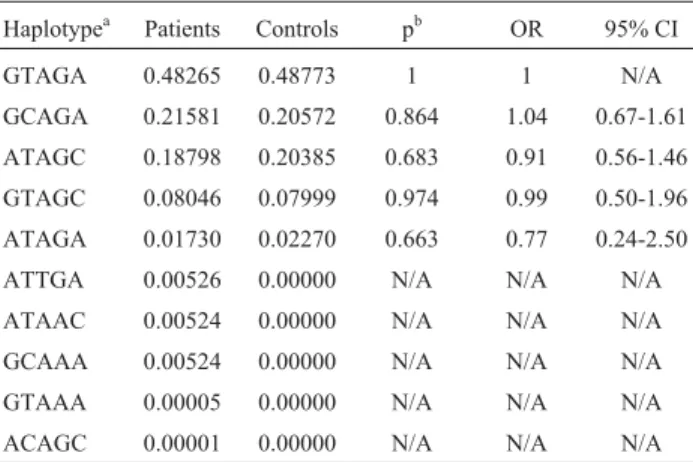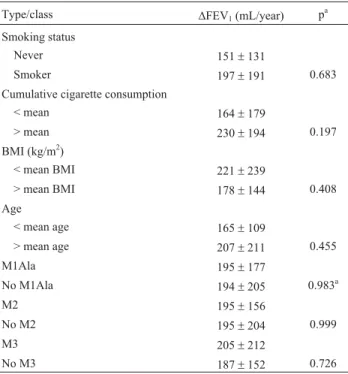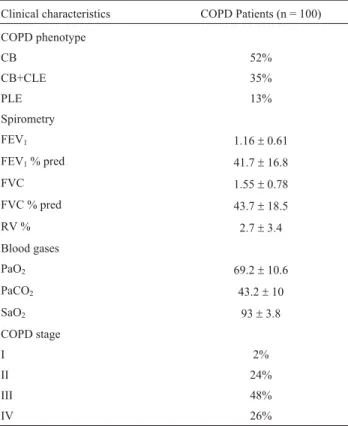Alpha-1 antitrypsin gene polymorphism in
Chronic Obstructive Pulmonary Disease (COPD)
Sabri Denden
1*, Amel Haj Khelil
1*, Jalel Knani
2, Ramzi Lakhdar
1, Pascale Perrin
3,
Gérard Lefranc
4and Jemni Ben Chibani
11
Biochemistry and Molecular Biology Laboratory, Faculty of Pharmacy, Monastir, Tunisia.
2Pulmonology Department, CHU Tahar Sfar, Mahdia, Tunisia.
3
Institute of Evolution Sciences, University of Montpellier-II, France.
4Institute of Human Genetics, University of Montpellier-II, France.
Abstract
Alpha-1-antitrypsin (AAT) plays an important role in the pathogenesis of emphysema, the pathological lesion under-lying the majority of the manifestations of Chronic Obstructive Pulmonary Disease (COPD). In this study we tested the hypothesis that common AAT polymorphisms influence the risk of developing COPDs. We investigated PiM1 (Ala213Val), PiM2 (Arg101His), PiM3 (Glu376Asp), PiS (Glu264Val) and PiZ (Glu342Lys)SERPINA1 alleles in 100 COPD patients and 200 healthy controls. No significant differences were observed in allele frequencies between COPD patients and controls, neither did haplotype analysis show significant differences between the two groups. A cross-sectional study revealed no significant relationship between common SERPINA1 polymorphisms (PiM1, PiM2, PiM3) and the emphysematous type of COPD. In addition, FEV1annual decline, determined during a two-year
follow up period, revealed no difference among carriers of the tested polymorphisms.
Key words:alpha-1 antitrypsin,SERPINA1polymorphisms, COPD, emphysema, lung function.
Received: January 16, 2009; Accepted: September 9, 2009.
Chronic obstructive pulmonary disease (COPD), a heterogeneous disorder, is a major cause of respiratory dis-ability and the fourth major cause of death world-wide (World Health Organization, 2000). Exposure to cigarette smoke is recognized as the main environmental risk factor involved (Teramoto, 2007). Severe Alpha-1-antitrypsin de-ficiency (AATD) is a proven genetic risk factor, with about 80% of the subjects develop the disease between 30 to 40 years or earlier, in spite of only 1%-3% of COPD cases be-ing due to severe AAT deficiency (Lomas and Silverman, 2001).
Alpha-1 antitrypsin (AAT) is a 52 kDa protein syn-thesized primarily by hepatocytes. Its main function is to inhibit the activity of neutrophile elastase in the lung. This is a protease capable of destroying the major structural pro-teins of the alveolar wall. Plasma AAT deficiency results in accelerated elastin degradation, leading to a loss of ventila-tor function and the subsequent development of emphy-sema (Mahadeva and Lomas, 1998). The AAT coding gene
SERPINA1 is highly polymorphic, with more than 125 SNPs reported in public databases, its most common alleles
being the normal M alleles and its subtypes (PiM1Ala, PiM1Val, PiM2, PiM3), besides the deficient alleles PiS and PiZ (Crystal, 1990). About 95% of the individuals with severe AATD are homozygous for PiZt (ATS/ERS, 2003), whereas PiSZ heterozygotes have approximately one-third of the normal AAT serum level, besides being highly prone to the development of diseases (Dahlet al., 2005). COPD risk among PiMZ heterozygotes has been previously ana-lyzed with controversial results. Meta-analysis indicates a slight increase in risk of COPD in PiMZ individuals, with no significant lung-function impairment, compared to PiMM (Hershet al., 2004).
A few studies on SERPINA1 common variants in COPD have been reported, also with controversial results. Matsuseet al.(1995), Shim (2001) and Kimet al.(2005) did not find a significant association between PiM1, PiM2 or PiM3 alleles and COPD, whereas Kwoket al.(2004) came across a significant increase in PiM1M3, PiM2M3 phenotypes and Guptaet al.(2005) reported a significant increase for the PiM3 allele in COPD patients.
For a better understanding of the association between
SERPINA1polymorphisms and COPD risk, we designed a case-control study to detect differences in the frequencies of common SNP alleles, haplotypes and genotypes,
be-www.sbg.org.br
Send correspondence to Denden Sabri. Biochemistry and Molecu-lar Biology Laboratory, Faculty of Pharmacy, 1, AV. Avicenne 5019, Monastir, Tunisia. E-mail: denden_sabri@yahoo.fr.
*These authors contributed equally to this work.
tween patients and controls in relation to common poly-morphisms.
We also investigated the relationship between com-monSERPINA1polymorphisms and main COPD clinical manifestations. The major AAT neutrophile elastase inhib-itory role is observed in alveolar parenchyma, the subse-quent deficiency in plasma AAT concentration mainly resulting in emphysema (Needham and Stockley, 2004). We therefore compared the distribution of SERPINA1
polymorphisms between the bronchial and emphysematous types of COPD. In addition, COPD patients underwent a two-year follow up, in order to evaluate the annual FEV1
(Forced Expiratory Volume in 1 s) decline rate in relation to commonSERPINA1alleles. FEV1is the hallmark of COPD
since it is affected by inflammation and remodeling of the small airways as well as by emphysematous destruction of the terminal airspaces (Weisset al., 2003).
The study population consisted of 100 COPD sub-jects who attended the Pneumology Department of Tahar Sfar Hospital in Mahdia. Inclusion criteria for patients with COPD were as follows: FEV1< 80% of predicted value
ad-justed for age, weight and height, and an improvement in FEV1following bronchodilator inhalation < 12% of
base-line FEV1. Asthmatic patients showing a persistent airflow
obstruction were excluded. COPD phenotype identification was based on chest radiographic and high-resolution com-puterized tomography (HRCT) density findings. Clinical characteristics of COPD patients are summarized in Table S1. Follow-up examinations were conducted with patients over a two-year period after baseline, with annually re-peated spirometry tests. AATD individuals were excluded from analysis. Two hundred healthy controls were enrolled for the case-control study. They were recruited from a blood donor’s cohort of Fattouma Bourguiba Hospital in Monastir. Subjects with respiratory diseases, or any family history of lung disease, were excluded. The distribution of both patients and controls, according to demographic char-acteristics, is shown in Table S2. Prior written informed consent was obtained from all the subjects according to the research protocol approved by the local ethics committee.
Total genomic DNA was extracted from peripheral blood leucocytes by a phenol-chloroform method. PCR-RFLP was employed for genotyping of PiM1 (Ala213 GCG ® Val GTG), PiS (Glu264 GAA ® Val GTA) and PiZ (Glu342 GAG®Lys AAG) polymorphisms, as previ-ously described (Ferrarottiet al., 2004). Briefly, we per-formed PCR amplification using exon III primers to detect the S and 213Ala/Val variants and exon V for the Z variant. The reactions were carried out in an I-cycler Thermal Cy-cler (Bio-Rad Laboratories). 4 U ofSexAIandHpy99I re-striction enzymes (New England Biolabs) were used to digest 4mL each of exon III and exon V amplified DNA, re-spectively. Genotyping of PiM2 (Arg101 CGT ® His CAT) and PiM3 (Glu376 GAA ® Asp GAC) was per-formed using hybridization probe analysis on Light Cycler
480 Roche apparatus (Roche Diagnostics), using a com-mercial real-time assay (LightMix®, Roche Diagnostics). For each SNP, the primers flanking the SNP and the oligo-nucleotide probes were designed and synthesized by the manufacturer. The reaction mixture was prepared in a 96-well PCR plate and processed according to manufacturer’s instructions. Real-time PCR cycling conditions were as fol-lows: 95 °C for 5 min, followed by 35 cycles of 95 °C for 10 s, 62 °C for 15 s and 72 °C for 15 s. After amplification, PCR products were analyzed in a melting step of 40-95 °C. Melting data were analyzed using the Genescanning mod-ule of the LightCycler 480 software.
Annual FEV1 decline (ml/year) was calculated as the difference between follow-up and baseline observed FEV1 values, divided by the number of months between the two surveys, and multiplied by 12. SPSS v.10.0 software was used for statistical analysis. Categorical variables were pre-sented as percentages, and intergroup differences were compared usingc2test or Fisher’s exact tests. Continuous variables, described as mean± standard deviation, were compared between the groups using Student’s t test. Hardy Weinberg equilibrium tests and the estimation of allele and haplotype frequencies were performed using HPlus v. 2.5 software.
The frequency of PiM1, PiM2, PiM3, PiS and PiZ al-leles and genotypes between COPD patients and healthy controls, was determined and compared (Table 1). Geno-types for all the polymorphisms were within Hardy-Weinberg proportions. There was no significant difference in the genotypic and allelic distribution of normal PiM1, PiM2 and PiM3 variants between subjects and controls. Deficient PiS and PiZ alleles were only reported in patients, with no apparent significant difference in relation to con-trols. Ten haplotypes were selected for studying by the expectation maximization procedure (Table 2), with no sig-nificant differences being detected between patients and controls by statistical comparison.
COPD patients were classified according to their pre-dominant phenotype as follows: 53 subjects showed the bronchial type of the disease (chronic bronchitis group; mean age: 72.1±7.6 years); 47 presented a predominant parenchymal destructive change (centrolobular and panlo-bular emphysema groups; mean age: 69.5± 12.2 years). Univariate analysis was employed to verify whether there were differences in COPD phenotypes amongSERPINA1
genotypes (M1Ala containingvs. non M1Ala containing; M2 containingvs.non M2 containing and M3 containing
vs.non M3 containing). The relationship between FEV1
an-nual decline, smocking and BMI and COPD phenotypes was also examined. No significant differences were de-tected (Table 3).
Lung function impairment in patients was assessed by the annual FEV1decline rate. After exclusion of AAT
defi-cient individuals, 96 patients underwent a two-year follow up Annual FEV1decline means were compared according
to age, smoking habits andSERPINA1polymorphisms. No significant relationship between annual FEV1decline and
the tested variables was detected (Table 4).
In summary, our findings are consistent with observa-tions that there is no significant difference in the frequency of commonSERPINA1variants in COPD patients, when
Table 2-SERPINA1SNP haplotypes in COPD patients and controls.
Haplotypea Patients Controls pb OR 95% CI
GTAGA 0.48265 0.48773 1 1 N/A
GCAGA 0.21581 0.20572 0.864 1.04 0.67-1.61
ATAGC 0.18798 0.20385 0.683 0.91 0.56-1.46
GTAGC 0.08046 0.07999 0.974 0.99 0.50-1.96
ATAGA 0.01730 0.02270 0.663 0.77 0.24-2.50
ATTGA 0.00526 0.00000 N/A N/A N/A
ATAAC 0.00524 0.00000 N/A N/A N/A
GCAAA 0.00524 0.00000 N/A N/A N/A
GTAAA 0.00005 0.00000 N/A N/A N/A
ACAGC 0.00001 0.00000 N/A N/A N/A
a
Haplotype frequency determined using expectation maximization me-thod;bFisher’s exact test.
Table 1-SERPINA1genotypes and alleles in COPD patients and controls.
Genotype Allele HWE p
Ala213Val CC CT TT C T
Controls 0.63 0.33 0.04 0.79 0.21 0.699a
Patients 0.63 0.31 0.06 0.78 0.22 0.418a
p 0.764a 0.887a 0.516a 0.671a
OR (95% CI) 1.096 (0.718-1.672)
Arg101His GG GA AA G A
Controls 0.57 0.38 0.05 0.77 0.23 0.440a
Patients 0.61 0.36 0.03 0.78 0.22 0.380a
p 0.862a 0.937a 0.477b 0.770a
OR (95% CI) 0.939 (0.617-1.430)
Glu376Asp AA AC CC A C
Controls 0.49 0.45 0.06 0.73 0.28 0.217a
Patients 0.53 0.39 0.08 0.73 0.27 0.648a
p 0.348a 0.413a 0.497a 0.798a
OR (95% CI) 0.951 (0.645-1.402)
Glu264Val AA AT TT A T
Controls 1 0 0 1 0 N/A
Patients 0.98 0.02 0 0.99 0.01 0.917a
p 0.193b 0.193b N/A 0.193b
OR (95% CI) 10.199 (0.487-213.501)
Glu342Lys GG GA AA G A
Controls 1 0 0 1 0 N/A
Patients 0.98 0.02 0 0.99 0.01 0.917a
p 0.193b 0.193b N/A 0.193b
OR (95% CI) 10.199 (0.487-213.501)
HWE: Hardy-Weinberg Equilibrium.aPearson’sc2test;bFisher’s exact test.
Table 3- Association studies of bronchial and emphysematous COPD
types with annual FEV1 decline (DFEV1), cigarette smoking, body mass index (BMI) andSERPINA1genotypes.
Type/Class COPD phenotype p
CB CLE+PEL
DFEV1(ml/year) 171±137 232±239 0.243 a
Cumulative cigarette consumption
59.41±29.22 51.97±28.68 0.230a
BMI (kg/m2) 24.33±3.70 22.77±5.21 0.117a
M1Ala 0.41 0.53
No M1Ala 0.58 0.47 0.306b
M2 0.45 0.45
No M2 0.54 0.54 1b
M3 0.39 0.53
No M3 0.60 0.46 0.184b
CB: Chronic Bronchitis; CLE: Centrolobular Emphysema; PLE: Panlo-bular Emphysema; Cumulative cigarette consumption = number of packs smoked per day multiplied by years of consumption. M1Ala: heterozy-gous and homozyheterozy-gous for Ala213 allele; no M1Ala: homozyheterozy-gous for Val213 allele; M2: heterozygous and homozygous for His101allele; no M2: homozygous for Arg101 allele; M3: heterozygous and homozygous for Asp376 allele; no M3: homozygous for Glu376 allele.
compared to healthy controls. We also verified that there is no correlation between these alleles and the manifestation of emphysema, since there was no difference in their distri-bution in patients with bronchial and emphysematous types of COPD. Furthermore, no significant relationship between
SERPINA1polymorphisms and annual FEV1decline
eval-uated over a two-year period in COPD patients was found. To our knowledge, this is the first report on clinical mani-festations of COPD in relation to common AAT variants.
Acknowledgments
This work was supported by a grant from the Ministry of Education and Scientific Research in Tunisia.
References
ATS/ERS Statement (2003) Standards for the diagnosis and man-agement of individuals with alpha-1 Antitrypsin deficiency. Lung disease section. Am J Respir Crit Care Med 168:823-849.
Crystal RG (1990)a1-antitrypsin deficiency, emphysema, and liver disease genetic basis and strategies for therapy. J Clin Invest 85:1343-1352.
Dahl M, Hersh CP, Ly NP, Berkey CS, Silverman EK and Nor-destgaard BG (2005) The protease inhibitor PI*S allele and COPD: A meta-analysis. Eur Respir J 26:67-76.
Ferrarotti I, Zorzetto M, Scabini R, Mazzola P, Campo I and Luisetti M (2004) A novel method for rapid genotypic iden-tification of alpha1-antitrypsin variants. Diagn Mol Pathol 12:160-163.
Gupta J, Bhadoria DP, Lal MK, Kukreti R, Chattopadhaya D, Gupta VK, Dabur R, Yadav V, Chhillar AK and Sharma GL (2005) Association of the PIM3 allele of the alpha-1-anti-trypsin gene with chronic obstructive pulmonary disease. Clin Biochem 38:489-491.
Hersh CP, Dahl M, Ly NP, Berkey CS, Nordestgaard BG and Silverman EK (2004) Chronic obstructive pulmonary dis-ease in alpha 1-antitrypsin PI MZ heterozygotes: A meta-analysis. Thorax 59:843-849.
Kim CH, Yim JJ, You CG, Lee CT, Kim YW, Han SK and Shim YS (2005) Alpha-antitrypsin genotypes in Korean patients with chronic obstructive pulmonary disease. Respirology 10:223-228.
Kwok JSY, Lawton JWM, Yew WW, Chau CH, Lee J and Wong PC (2004). Protease inhibitor phenotypes and serum al-pha-1-antitrypsin levels in patients with COPD: A study from Hong Kong. Respirology 9:265-270.
Lomas DA and Silverman EK (2001) The genetics of chronic ob-structive pulmonary disease. Respir Res 2:20-26.
Mahadeva R and Lomas DA (1998) Genetics and respiratory dis-ease* 2: Alpha 1 antitrypsin deficiency, cirrhosis and em-physema. Thorax 53:501-505.
Matsuse T, Fukuchi Y, Matsui H, Sudo E, Nagase T and Orimo H (1995) Effect of cigarette smoking on pulmonary function in each phenotype M of a-1-Protease inhibitor*. Chest 107:395-400.
Needham M and Stockley RA (2004)a1-antitrypsin deficiency * 3: Clinical manifestations and natural history. Thorax 59:441-445.
Shim YS (2001) Epidemiological survey of chronic obstructive pulmonary disease and alpha-1 antitrypsin deficiency in Ko-rea. Respirology 6:S9-S11.
Teramoto S (2007) 1. COPD pathogenesis from the viewpoint of risk factors. Intern Med 46:77-79.
Weiss ST, DeMeo DL and Postma DS (2003) COPD: Problems in diagnosis and measurement. Eur Respir J 21:4s-12s.
Internet Resources
HPlus software v 2.5, http://qge.fhcrc.org/hplus (June 18, 2007). World Health Organization (2000) the World Health Report 2000,
http://www.who.int/whr/2000/en/ (December 3, 2008).
Supplementary Material
The following online material is available for this article: - Table S1 - Clinical characteristics of COPD patients at baseline.
- Table S2 - Demographic characteristics of COPD patients and healthy controls
This material is made available as part of the on-line article from http://www.scielo.br.gmb.
Associate Editor: Francisco Mauro Salzano
License information: This is an open-access article distributed under the terms of the Creative Commons Attribution License, which permits unrestricted use, distribution, and reproduction in any medium, provided the original work is properly cited.
26 Dendenet al.
Table 4- Association studies of lung function impairment with smoking,
body mass index (BMI), age andSERPINA1genotypes.
Type/class DFEV1(mL/year) p a
Smoking status
Never 151±131
Smoker 197±191 0.683
Cumulative cigarette consumption
< mean 164±179
> mean 230±194 0.197
BMI (kg/m2)
< mean BMI 221±239
> mean BMI 178±144 0.408
Age
< mean age 165±109
> mean age 207±211 0.455
M1Ala 195±177
No M1Ala 194±205 0.983a
M2 195±156
No M2 195±204 0.999
M3 205±212
No M3 187±152 0.726
Cumulative cigarette consumption = number of packs smoked per day multiplied by years of consumption. M1Ala: heterozygous and homozy-gous for Ala213 allele; no M1Ala: homozyhomozy-gous for Val213 allele; M2: heterozygous and homozygous for His101 allele; no M2: homozygous for Arg101 allele; M3: heterozygous and homozygous for Asp376 allele; no M3: homozygous for Glu376 allele.
a
Clinical characteristics COPD Patients (n = 100)
COPD phenotype
CB 52%
CB+CLE 35%
PLE 13%
Spirometry
FEV1 1.16±0.61
FEV1% pred 41.7±16.8
FVC 1.55±0.78
FVC % pred 43.7±18.5
RV % 2.7±3.4
Blood gases
PaO2 69.2±10.6
PaCO2 43.2±10
SaO2 93±3.8
COPD stage
I 2%
II 24%
III 48%
IV 26%
CB: Chronic Bronchitis; CLE: Centrolobular Emphysema; PLE: Panlo-bular Emphysema; FEV1: Forced Expiratory Volume in 1 s (L); FVC: Forced Vital Capacity (L); FEV1% pred: percentage of the predicted FEV1value adjusted to age, height and weight. FVC % pred: percentage of the forecast FVC value adjusted to age, height and weight. RV: Reversibil-ity of baseline FEV1following bronchodilator inhalation; PaO2: arterial oxygen partial pressure (mm Hg); PaCO2: arterial carbon monoxide partial pressure (mm Hg); SaO2: Arterial oxygen saturation (%).
Table S2- Demographic characteristics of COPD patients and healthy controls.
Demographic characteristics COPD patient (n = 100) Controls (n = 200) p
Age 69.45±12.34 43.86±8.97 0.00a
male:female 98:2 189:11 0.15b
BMI 24.5±4.0 24.4±2.9 0.80a
Smoking status
Never 7 16
Ex 52 89
Current 41 95 0.09b
Cumulative cigarette consumption 53.74±29.76 48.41±23.86 0.14a
Geographic origin in Tunisia
North 0 4
Center 100 192
South 0 4 0.08b
BMI: Body mass index, weight (kg)/(height (m))2. Cumulative cigarette consumption = number of packs smoked per day multiplied by years of consump-tion.
a


